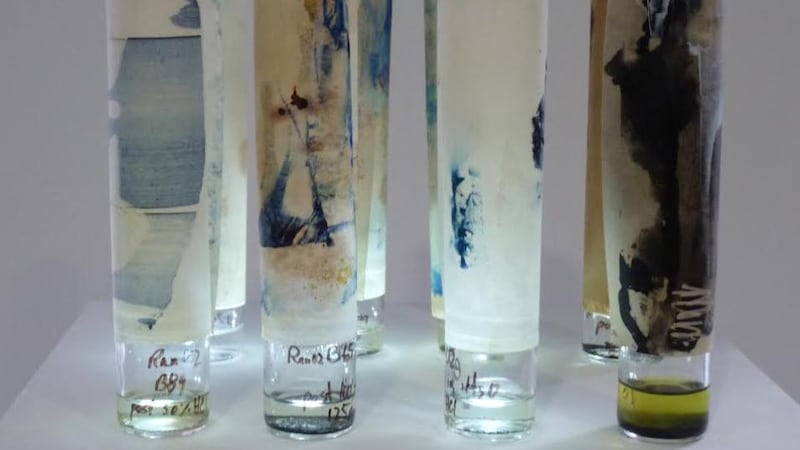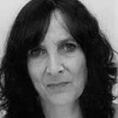In her studio, artist Siobhán McDonald is showing me a series of eight small glass jars, standing on a perspex plinth, that contain what look like tiny fragments of wood in various pale-coloured liquids. Each jar has a description and date scrawled in felt-tip pen. Placed vertically on the jars, covering their tops, are rolled-up tubes of calfskin, which have been used as canvasses for abstract paintings in a variety of colours.
“We thought about putting these fragments in little square glass boxes for the display, but I decided I wanted to keep them in the original lab containers,” she says. “I wanted the truth of that.”
The containers have been lent to McDonald by palaeobiologist Prof Jenny McElwain, with whom she has been collaborating at the O’Brien Centre for Science at UCD, where McDonald was an artist in residence. It’s part of the Oxyevol project, funded by the European Research Council, which is exploring the role of atmospheric oxygen in plant evolution over the past 400 million years. The fragments at the bottom of each jar are pieces of the earliest plants that evolved on Earth – each from a different place and epoch. The paintings are McDonald’s response to them.

“We had a lot of conversations about what the environment would have been like in each era,” says McDonald. “I tried to imagine what it would have been like to be alive 50 million years ago. How would it have looked if I was sitting there on a rock – what would the sunset have looked like?”
Collaborations between art and science are becoming more common. But working in the realm of science is nothing new for McDonald, who has always seen the disciplines as two sides of the same coin.
The Monaghan-born artist thought about studying geology before ending up in art, and that curiosity has fed her work and taken her to places far beyond the confines of the studio. It has taken her to the core of the earth and will soon take her to its end.
Seismographs
Her exhibition The Eye of the Storm in Galway Arts Centre in 2012 showed work inspired by her research into early seismographs made by Irish Jesuits in the 1920s. They used smoke-blackened paper on which, via a delicate arrangement of slim levers, a prism scratched out the traces of an earthquake's seismic signature. McDonald travelled to Göttingen in Germany to visit the only seismic station left in the world that still uses the process.
That exhibition also included work carried out on a trip to Iceland McDonald made with a group of scientists from the UCD Earth Institute, where they studied the acoustic signals coming from the Eyjafjallajökull volcano. Using her smoke-blackening skills, McDonald spread a roll of paper over the entrance to the volcano to take a print of its crater’s outline. “I wanted to do something other than just take photos – to try and capture the truth of it.” She also worked with a composer to make music based on the data recorded inside the volcano by the scientists’ detectors.
On the day I meet her in her bright, pleasantly chaotic studio in the O'Brien centre, she is working on her exhibits for a group show, Welcome Disturbances, at the Lab in Foley Street, in Dublin's north inner city. On the ground are two huge black abstract charcoal drawings. They were done with a mixture of crushed bone and prehistoric charcoal given to her by Prof McElwain.
“It was gathered from the site of a flash forest fire that happened 205 million years ago in Greenland. And so I wanted to try and convey the feeling of a cosmic event – of a meteor crashing through the atmosphere and landing on earth – of forces meeting and colliding, and in a sense to connect with that ecological event and resurrect the fire, to recreate it as something new.”
In June, as part of the Arctic Circle Residency programme, she will join a group of international scientists, artists, educators and innovators who will live and work for three weeks aboard a Barquentine tall ship in the waters of the international territory of Svalbard, an Arctic archipelago just 10 degrees latitude from the North Pole.
McDonald will be working on a project she calls Magnetic North, examining the records of various explorers of their physical journey through this volatile region, most of which are kept in the museum in Svalbard.
For example, in 1895, SA Andree attempted to fly over the North Pole in a hot-air balloon. In 1930, the remains of the expedition were found, trapped in the ice. McDonald will study the diaries, maps and photographic plates found among the frozen remains. She aims to capture the vastness of the waters and the rich history of exploration in this territory and to draw attention to the tipping of natural balances in this environment.
In addition to the earth, the work will soon take her into space, through her collaboration with Enbio, an Irish company of material scientists who in 2014 won a €500,000 contract with the European Space Agency. They are creating a heat-resistant shield for the ESA’s Solar Orbiter, a planned sun-observing satellite due to be launched in 2017.
The Orbiter will travel nearer to the sun than any previous space craft. The protective coating will be made of the same crushed, burned bone used in prehistoric cave paintings – and by McDonald in her vellum paintings. Deoxygenated bone is virtually indestructible. She has been experimenting with baking bone and using it to make small maps and sculptures.
As the sky outside darkens, I return to the glass jars with their plant fragments and rolled-up vellum paintings and the truth that McDonald so assiduously pursues and expresses. In this case she chose the functional lab jars rather than more conventionally beautiful vessels. How important is the aesthetic aspect of her work – is it important that it is visually appealing as well as as investigative?
“It’s really important,” she says. “It’s not that it must look pretty – things can be ugly and have real power – but it has to have some kind of impact on the viewer without them having to read all the accompanying text. I know myself, when I go into a gallery, I want to experience the work directly before I read anything about it.
“For me, with a piece, it’s not so much how it looks but how it resonates. And yes, it’s interesting to read afterwards that it was made with burned bone, or whatever, but the piece has to work by itself.”
Welcome Disturbances is at The Lab, Dublin, until April 11th, thelab.ie. As part of the exhibition, on March 25th at 7pm McDonald will present her short film Continuum, which documents a set of ancient Irish coral fossils. Coiscéim dancer Emma O'Kane will respond to the film with a dance performance, for which composer Irene Buckley has written a sound piece. ucdartinscience.com, siobhanmcdonald.com








